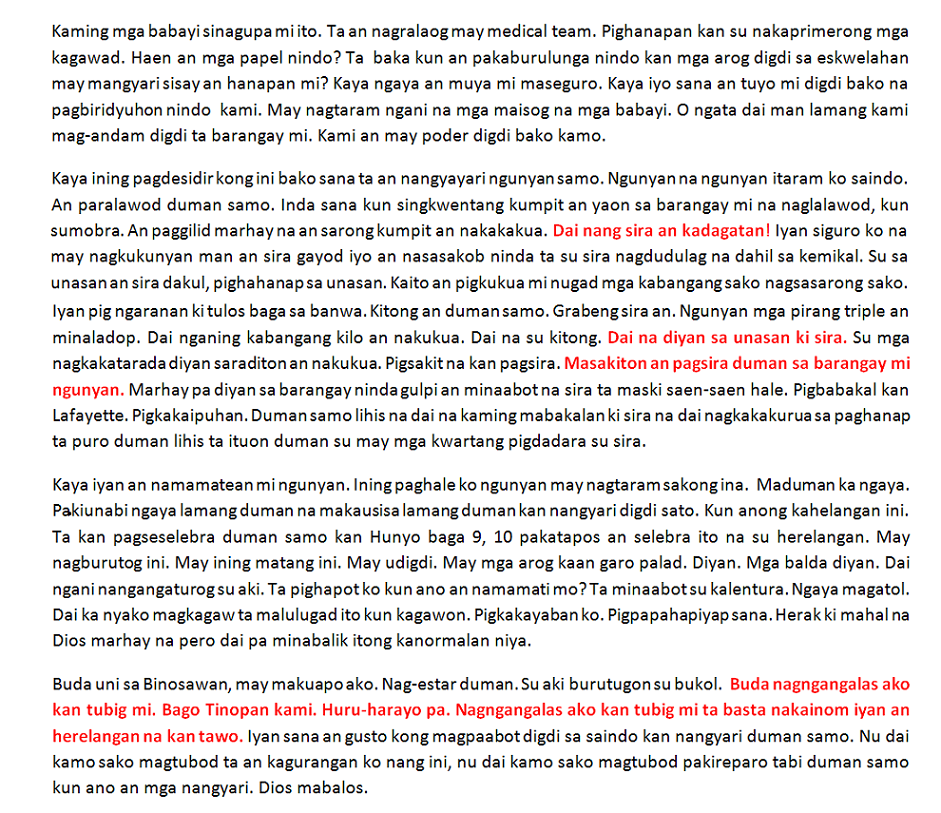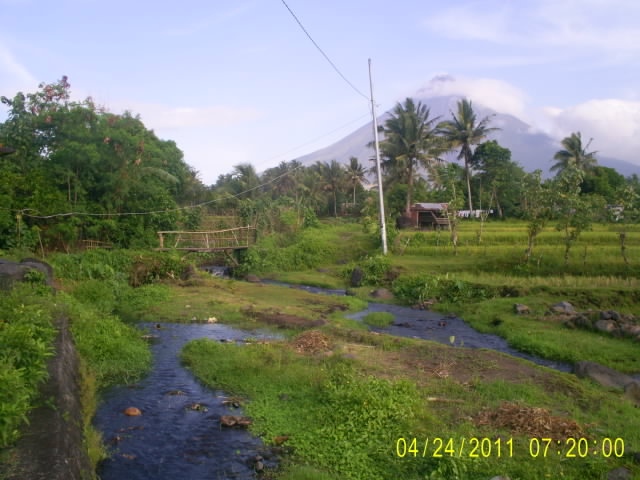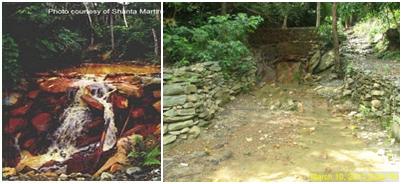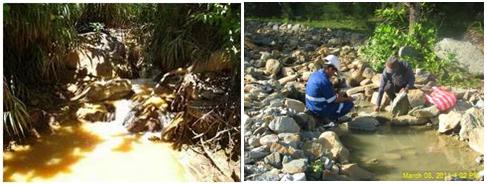Nick McKenzie
AS JUANITA Cut-ing tells of the armed soldiers who arrived at her door, her husband prepares breakfast. With the flick of a knife, he cuts the neck of a bony chicken and drains its blood into a bowl. In the remote village of Didipio in the north of the Philippines, little is wasted.
The soldiers came to the stilt home in the middle of last year to enforce a summons that the mother of three has repeatedly ignored, ordering her to vacate her home of 25 years.
"When the military men arrived, I felt so troubled and nervous," says Cut-ing. "But then I told myself, 'Why should I be afraid? This is my land.' "
Not for long. Her house and dozens like it sit on land destined to be flooded. In their place will be a dam to store waste from an open-pit gold and copper mine. Melbourne-based company OceanaGold plans to dig up $3.6 billion worth of gold and copper over 15 years from beneath a small hill overlooking Didipio, a village settled 50 years ago by the Iffugao, indigenous farming people.
Where OceanaGold points to the money, jobs and improved infrastructure it is bringing, Cut-ing sees a community divided and the destruction of her dream to fulfil a tradition of passing her house and farmland to her children.
"What will happen in 15 years, when the mine company packs up and goes?" she says. In the time it takes her to finish her story, the chicken is plucked, boiled and served for breakfast. As Cut-ing serves the cooking liquid as a drink, she seems almost unaware that in 12 months, the mine will roar to life and her home will be gone.
Her story is being played out in mineral-rich developing nations across the world as Australian miners lead the charge of First World companies seeking to capitalise on the mining boom. Companies emphasise the economic opportunities they bring to their poor and often unstable hosts — a third of the Philippines' 88 million people live on less than $2 a day — and insist that modern mines can be environmentally and socially sustainable.
Critics highlight other aspects of the global mining march: they allege corruption, lacklustre environmental oversight and unsavoury relationships with the local military or private security teams.
Non-government organisations such as Oxfam, which last year subjected OceanaGold to a damning report (rejected by the company), as well as politicians such as Greens senator Christine Milne, say Third World countries cannot hold foreign miners to account.
"Companies get away with shonky environmental and human rights practices in those countries. Australian companies overseas need to be held accountable in Australia," Milne says.
Australian Federal Police assistant commissioner Peter Drennan, who oversees investigations into companies alleged to have bribed foreign officials or accused of complicity in war crimes, says most Australian companies operate within the law. But he also says that only the naive would believe corruption or misconduct doesn't sometimes happen. If it does, investigating it in a developing nation can be trying.
"The environment in which these businesses are operating, the changing nature of the governments, the role of public officials — it is a very complex and difficult environment," Drennan says.
Finding the truth about mining companies in the Third World is complex and often confusing. The Philippines has become a flashpoint, especially for Australian miners, because of a concerted campaign in the past three years by the Government to attract foreign investment. Incentives include giving foreign companies full ownership of mines and generous tax concessions. Of the Philippines' 50 priority mineral projects, 12 involve Australian players.
The issue is deeply contested. On one side are the anti-mining Catholic Church and NGOs; on the other, an industry promising to maintain human rights and environmental standards and an often unstable national Government desperate to attract foreign capital. Between the claims and counter-claims, both sides have grievances. The miners say they are unfairly labelled environmental vandals, while the royalties they give communities are ignored. The critics point to irregular payments, local officials on company payrolls and avoidable toxic spills.
Peter Duyapat, a short, stocky indigenous man, farms using the water from one of Didipio's two rivers that will be diverted to make way for the mine. In the 1990s, Duyapat, a village councillor, worked for another Australian company, Climax Mining, guarding its bulldozer. Until it was taken over by OceanaGold in 2006, Climax held the rights to the Didipio project and spent more than a decade getting the required approvals from the local and national authorities. But in the late '90s, before Duyapat was to cast his council vote on the mine, he conducted a field trip to troubled mining projects elsewhere in the Philippines and decided the risks were too great for his village.
Duyapat's house is a sturdy, bare wooden building with a metal roof held down by rocks, a cause for derision among pro-mine supporters. "They think I am mad for not taking any more work from the mine," he says.
Nor did Duyapat accept an unusually generous relocation deal, greater than that offered to other villagers, from Climax company employee Carlos Migleas. By Migleas' own admission, he offered Duyapat a "double deal" involving the purchase of his land as well as buying him a new property. The offer was made before Duyapat had voted on the council about whether to endorse the mine. Getting Duyapat's backing could have reversed much of the anti-mine sentiment in the village.
In refusing Migleas' offer, Duyapat says he asked him: "Now you know you cannot buy all the people in Didipio, what will be your next step?" When the local council voted to approve the mine in 1999, Duyapat was the lone dissenter. At the time, many of his fellow councillors were working for the company, common practice in the Philippines.
The director of the national mine bureau, Horatio Ramos, acknowledges that employing local councillors, who must sometimes approve and scrutinise company operations, is ethically questionable. He also acknowledges that the multiple permits and approvals needed to run a mine, while ostensibly created to safeguard the environment and local residents, create opportunities for corruption. But Ramos is also a realist.
"That they hire your sons so you can disperse with some minor favour; I do not think that is corruption. For me, I look at it as a minor thing, giving favours. I do not know if you are a moralist, but I am not."
OceanaGold's chief executive, Stephen Orr, defends the employment of local officials and says an internal investigation by the company has found no evidence of irregular offers to local people, which are banned by OceanaGold. "Some people have a lot to offer from a public official standpoint in terms of representing the community. And they also happen to be exceptional employees for us as well," Orr says.
Under mining laws that require royalties to be paid to the local community, Orr says OceanaGold will contribute $US550,000 a year to projects that will long outlast the company in Didipio. The company has already brought jobs, better roads, a new school, scholarships and medical clinics.
Orr says the use of armed officials to deal with locals who refuse to accept generous company compensation offers to leave their homes is a matter for the Government. "We specifically requested there not be police or military presence."
Part of OceanaGold's challenge is to convince locals that it will not repeat the sins of other mining companies. In the rebel-infested southern Philippines, controversy has surrounded the use by some miners of heavily armed private security guards or military-trained, privately funded militia, who often operate with minimal accountability.
Then there is the environmental cost. Even though mining companies now operate under new laws and with new technology, past projects such as the Marcopper mine on the island of Marinduque cast a long shadow. A decade after the Marcopper mine shut down, fishermen on the banks of Marinduque's Boac River complain of itchy skin and depleted catches. The island's health officer, Dr Honesto Marquez, sees a stream of patients with conditions he suspects are linked to mine waste. "Heavy metals pollute little by little."
The Marcopper mine began poisoning the island of more than 200,000 people in 1969, when it was created by Canadian mining company Placer Dome in a secret partnership with corrupt dictator Ferdinand Marcos. Between 1974 and 1991, the mine dumped 200 million tonnes of waste into the sea. In 1996, the bursting of a waste dam pumped 4.4 million tonnes of waste into the Boac River, spoiling the aquatic environment. The then president, Fidel Ramos, declared a "state of calamity" on the island after high levels of heavy metals were found in the blood of 59 children. A United Nations team said the disaster had been preventable.
BY THEN, two Australians — the president of Marcopper, John Loney, and mine manager Steven Reid — had been charged with breaking environmental and mining laws. After lodging an appeal, both were allowed to leave the country. But the locals had nowhere to go. Despite 30 years of mining on the island, the community remains one of the nation's poorest.
As a child accompanying his father fishing in the bay used as a dump site by Marcopper, Wilson Manuba recalls feeling constantly sick. Thirty years later, after a series of chronic infections that failed to heal, Manuba was diagnosed with arsenic poisoning and given a choice: death or the amputation of his leg. He chose the leg and has received no compensation.
Since Loney and Reid were charged, three of the judges who presided over the ultimately unsuccessful appeals against the charges have died. The case itself, though, is still alive. Six months ago, two public prosecutors were assigned to revive court proceedings against the men. Reid, who now works as a senior executive with a mining company in Canada, and Loney, who chairs the board of WA-based firm Australian Mineral Fields, did not return The Age's calls or emails but have previously denied wrongdoing.
The Marinduque Government is suing in the US the company that took over Placer Dome, mining giant Barrick Gold, to get the tens of millions of dollars it says is still needed to clean up the island.
Placer Dome's conduct is still invoked by NGOs to attack new projects with no connection to Marinduque. It is partly why any environmental incident involving a new mining company can spark intense protest. So it was for Melbourne-based miner Lafayette, when things went wrong at its open-pit mine in late 2005.
The launch of the Australian-owned open-pit mine on the island of Rapu Rapu, south of Manila, was intended to herald a new era of foreign mining. But Lafayette rushed it. In mid-2005, metal prices skyrocketed and the company decided to start operations early, with environmental safeguards not in place. In October 2005, a pump malfunction caused 20 tonnes of mine waste, including cyanide, to flow into two creeks. Three weeks later, heavy rain and a poorly designed dam caused another spill. Mining officials later declared the two spills "very much preventable" and the result of company "negligence and unpreparedness".
Only a few fish were killed, and the company responded by overhauling its management and upgrading its operations, but Lafayette become the cause celebre of the anti-mining movement.
"The fish kill was not at all very serious," says mines bureau boss Horatio Ramos. "(But) it was serious to the extent that it destroyed the image of the industry — we were looking at Lafayette as a model, but it was not managed properly." The spills also hit Rapu Rapu's fishermen hard, as locals refused to buy their fish.
On top of an 18-month ban on its operations and a record fine of $258,000, the company was attacked by the Catholic Church and NGOs, with claims that Lafayette was responsible for subsequent fish kills. A banner draped over the local Catholic church depicts bloated and rotting fish alongside the words: "Lafayette says this is a hoax!!! Will the Government side with the people?"
During The Age's recent trip to Rapu Rapu, Lafayette community relations boss Joey Cubias said a village councillor had claimed he had to publicly oppose the mine or else "a bullet will welcome me back to my village".
Another local company manager, Teddy Marquez, chided Lafayette's former Australian managers for being "too honest" in presenting the 2005 spills. "Do you call it bread with sugar or do you call it cake?" he says.
Local priests say such an attitude is indicative of the industry's rhetoric. Bishop Lucilo Quiambao says Lafayette's royalties have flowed only to a small number of villages and will not lead to long-term economic prosperity.
He says his church has had to deliver rice to hungry fishermen unable to sell their catch because of continuing suspicion — fuelled by the church — that the fish aren't safe to eat. "Whom do the companies really favour — the poor or the investors?"
Others tell a different story. Former Lafayette employee and village mayor Reynold Asuncion says the mine has boosted the living conditions in his impoverished community. Last year, Lafayette employed 320 workers, including 180 from Rapu Rapu's 30,000-plus population. In several villages, Lafayette has built toilets and houses and supplied electricity and medical clinics. But it has not been enough to win over the region's most senior politician, provincial governor Joey Salceda, a former chief-of-staff and current economic adviser to President Gloria Arroyo. Salceda describes the company as "a thorn in my butt".
He claims Lafayette secured tax concessions several years ago in a "suspicious and highly irregular" manner that unfairly eroded what should have flowed into local and national coffers. "The point with Lafayette is that they do not even have a compliance officer (to safeguard against corrupt practices)."
Lafayette's managing director, David Baker, who joined the company in 2006, describes the attacks as without basis and politically motivated. His complaint is not without justification — one of Salceda's staffers encouraged locals to protest against the mine at a recent rally. The waiving of some taxes, Baker says, is a fair trade-off for the risks and costs of setting up a mine in a developing nation.
"You will find families that are enormously grateful for (the company) saving their child's life, providing what we would describe as minimal care but which for them is inaccessible," Baker says.
At the company's compound in mid-December, employees played The Age a slideshow describing Lafayette's contribution to the community. At the same time in Australia, its managers were trying to find a way out of the company's heavy debt, caused partly by the ban on its operations after the cyanide spill and typhoon-damage. The slide-show stated that Lafayette was "healing wounds, touching lives, fighting hunger, (giving) a brighter future". An hour later, in Reynold Asuncion's village, a teacher complained that he had not been paid by the company for four months. Two weeks later, Lafayette was placed into voluntary receivership.
The company's administrators are now searching for a foreign player to take over a mine potentially worth hundreds of millions of dollars. Waiting for them will be a community divided, from the locals in desperate need of work to those warier than ever of the promises of foreign miners.
Nick McKenzie is an Age investigative reporter.
Our comment later.
































































































































No comments:
Post a Comment